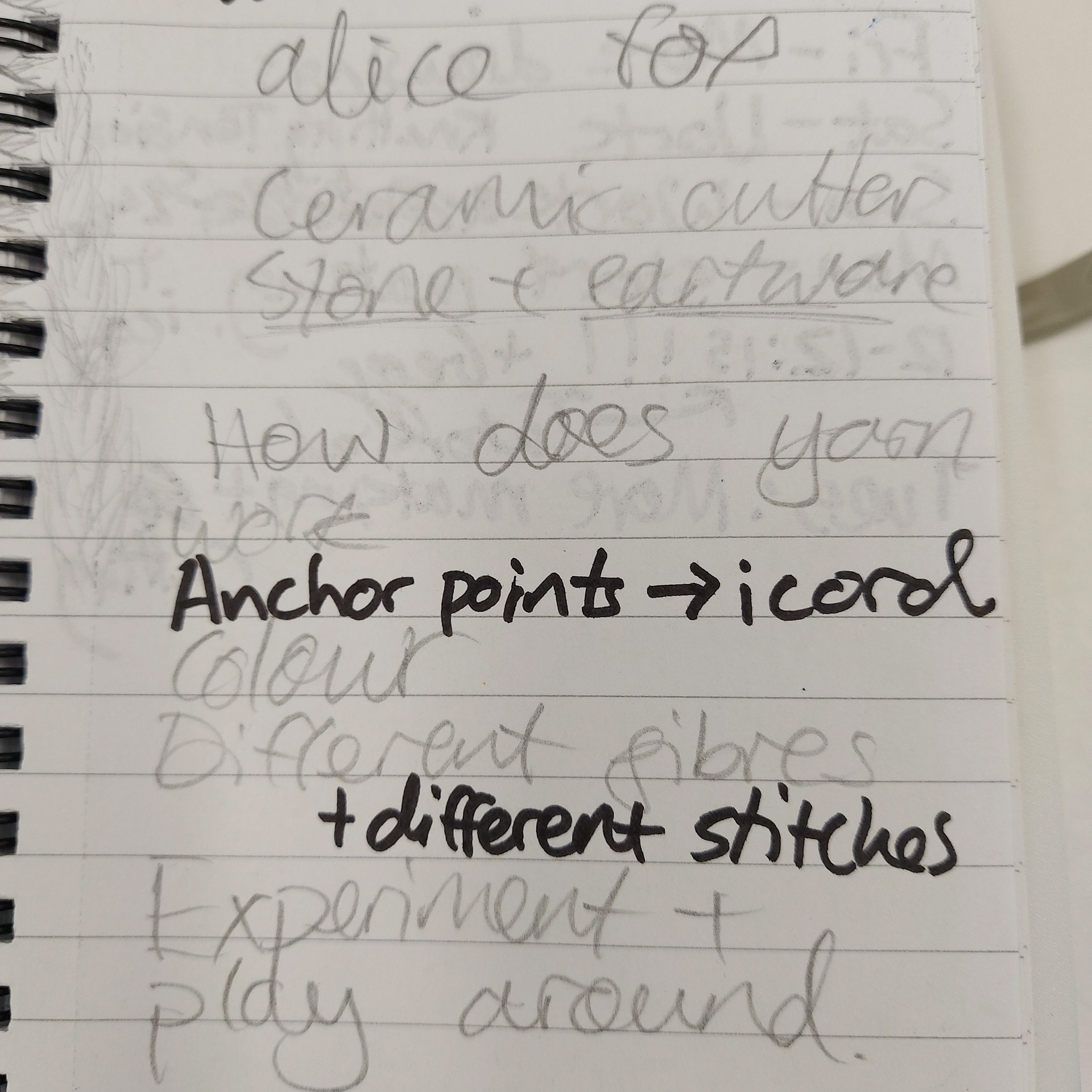I started my research looking into texture and use of materials. I knew that I wanted to continue my work using ceramic casted knitting so I wanted to look into ways that texture has been utilised within objects and art.
The bronze cast knotted sculptures reminded me of the casted knitting process and it interested me how the pieces were shaped. Rachel Carter creates these fluid pieces that stay in place in a spherical shape.
The fur lined teacup, saucer and spoon is an art piece by Meret Oppenheim, making us question the effect of texture in everyday use. We expect our cups and our functional crockery to be smooth so how would a furry surface effect out experience?
I then read into the effect of touch and texture of materials. In Ceramic Art, Magdelene Odundo talks about her work but also talks about the versatility of clay and its importance when it comes to building homes. I enjoyed hearing about the importance of clay to her and how it is used for so many purposes.
I then read into the effect of touch and texture of materials. In Ceramic Art, Magdelene Odundo talks about her work but also talks about the versatility of clay and its importance when it comes to building homes. I enjoyed hearing about the importance of clay to her and how it is used for so many purposes.


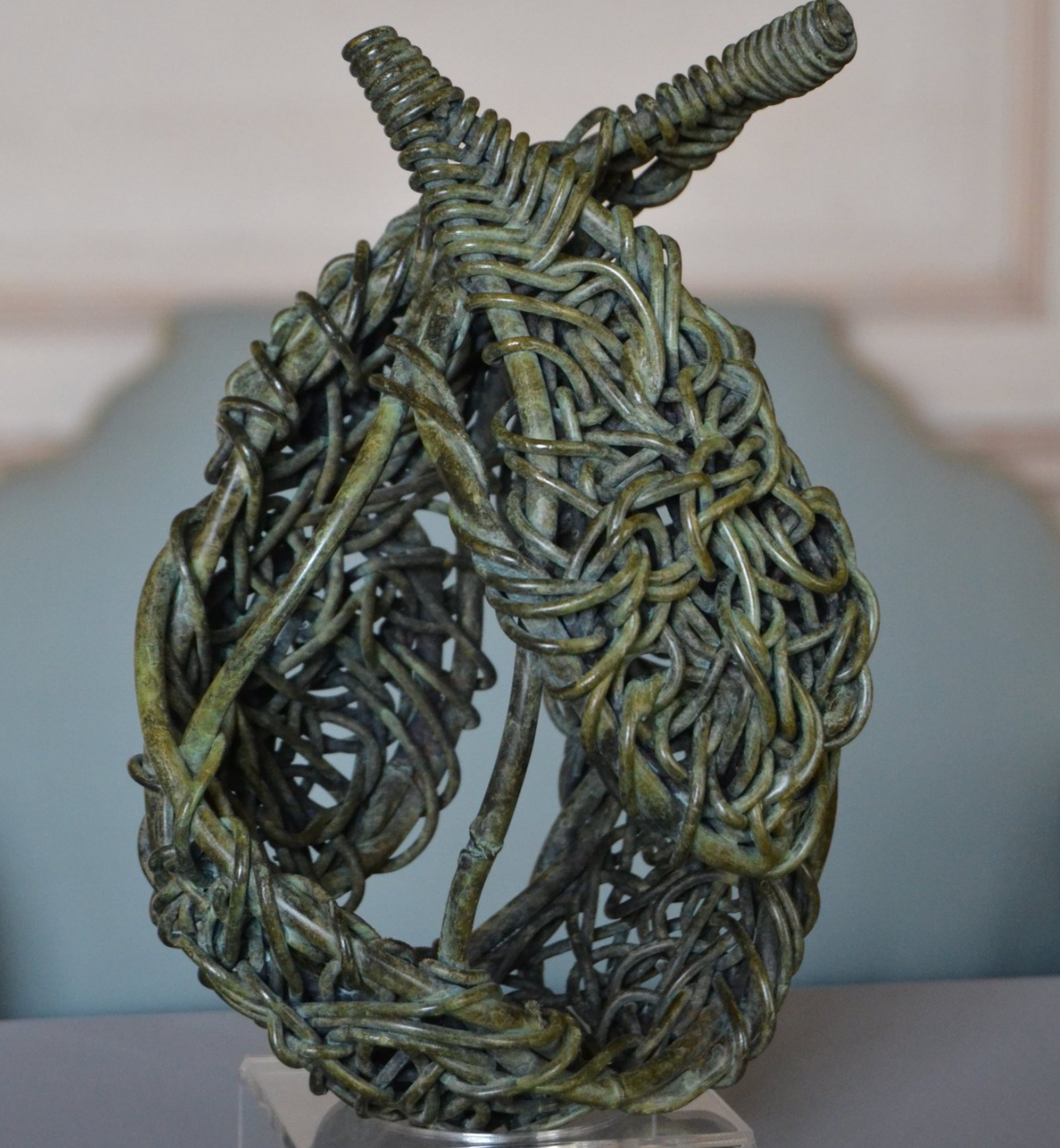
The feel of a glazed surface, its reflectivity, the weight of a piece in your hands, and the traces of the potter’s wheel or mold—all of these are experienced both visually and tactilely through what Sequoia Miller describes as “haptic sympathy,” meaning the human capacity to imagine feeling (and making) through looking and vice versa. - Ceramic Art - Margaret S Graves
Notes below made on what I had read about touch:
Touch has such an important role in the making of ceramics, but also the appreciation of it as well. Miller talks about a ‘haptic sympathy’ the feeling of knowing what a ceramic piece could feel like just by looking at it.
In Hands by Darian Leader he touches on how important the hands are in our early development and how they are connected to our body from birth.
Miller also touches on mimicry in clay, as the medium can be made into just about any form, mimicry of other materials, objects and textures has been used within ceramics throughout history, the use of knitting in ceramics takes on a knitted shape that is almost frozen in time, we know that it probably can’t stand up itself but it still looks knitted.
Haptic sympathy is already planting the feel and touch of a certain object in our minds. When we see something and think we know how something feels, why shouldn’t we. We might be surprised?
Albers focuses on how the surface of a design is important for whoever is handling an object. From the material to the smoothness of an object, these contribute to how we enjoy touching something compared to how we see something or use it. There is normally no function attached to the surface compared to it’s form or structure, however, it’s there to be touched and have a positive reaction with the hands.

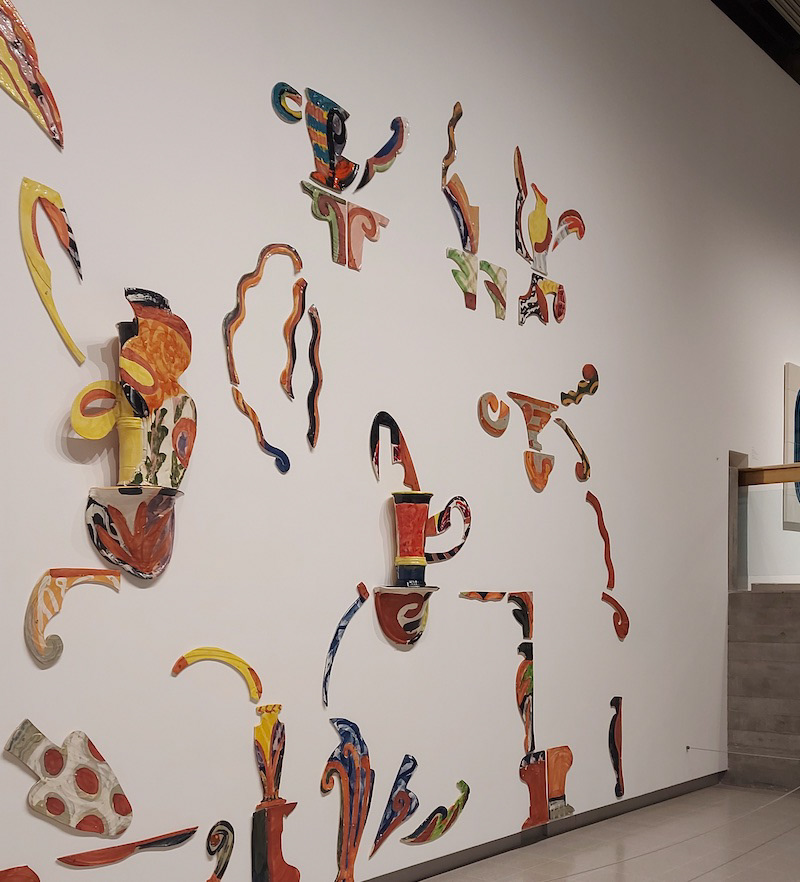
Betty Woodman
Within these pieces, Woodman uses ceramic tiles as as artwork. Not having them tesselate but instead utilising the space in between them to create a picture and this sort of wallpaper. I like that there are ceramic parts almost coming out of the wall as well.
Jackie Head
Again utilising the idea of ceramic tiles being a form of art, instead using geometric shapes and tessellation to create these works. I also like how in the first piece, the shapes almost look exploded, again utilising the space between the tiles.
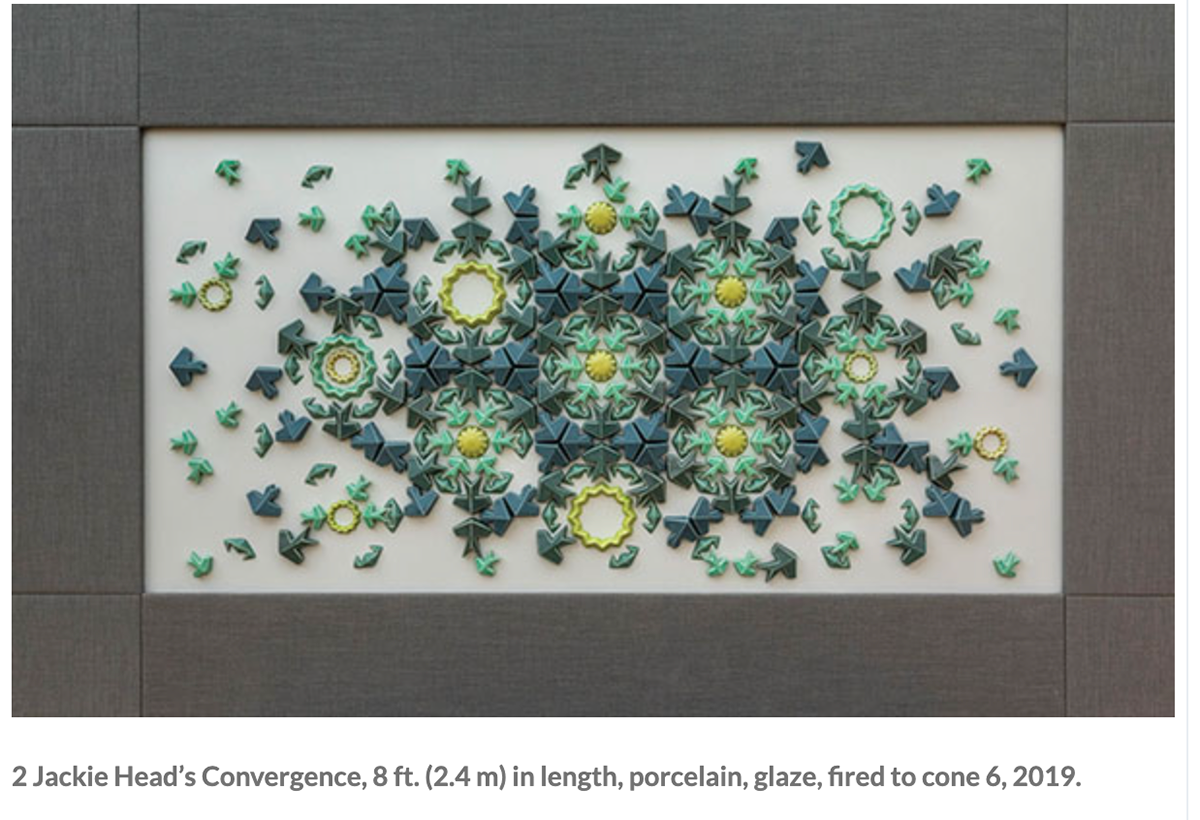
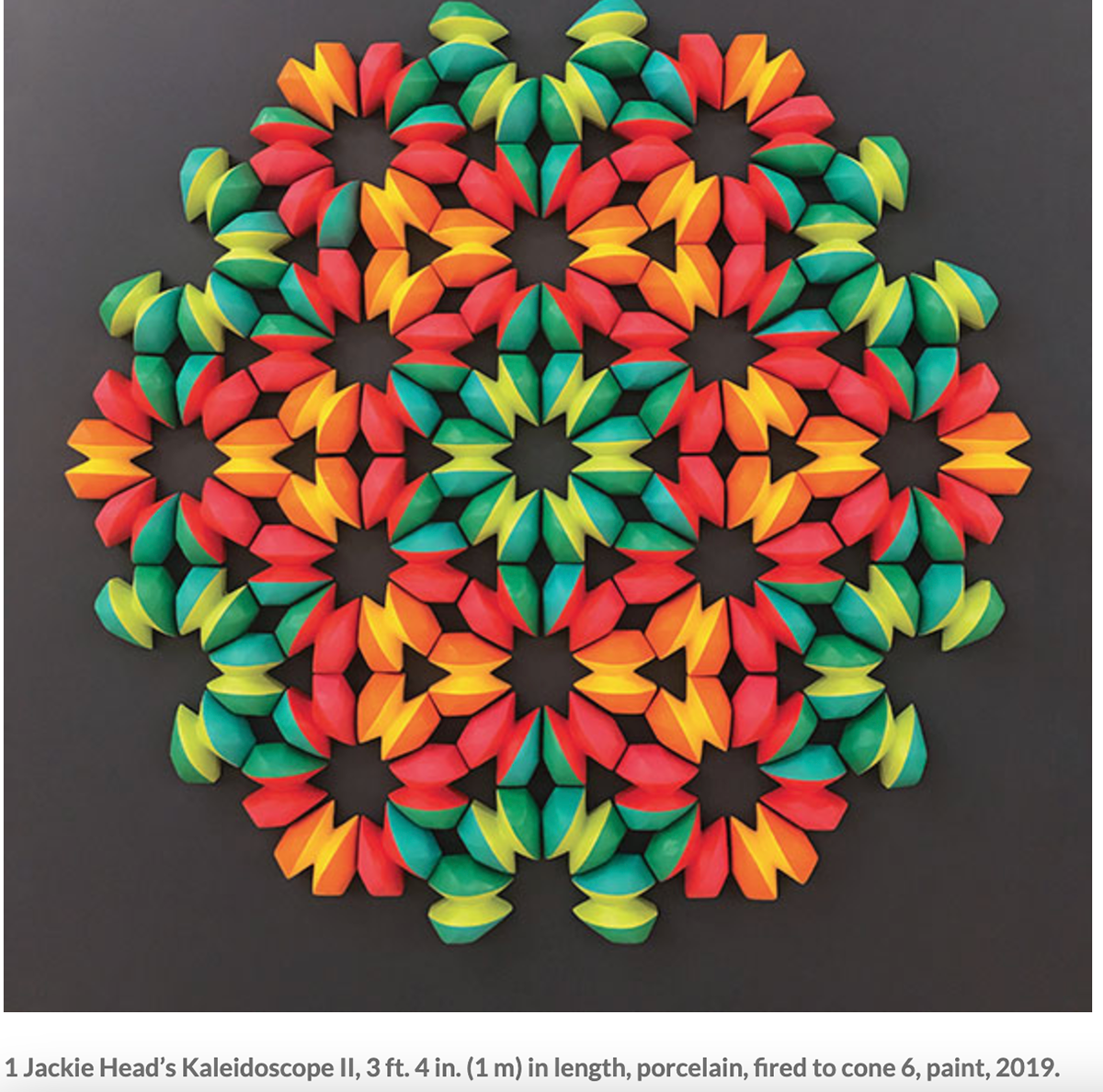
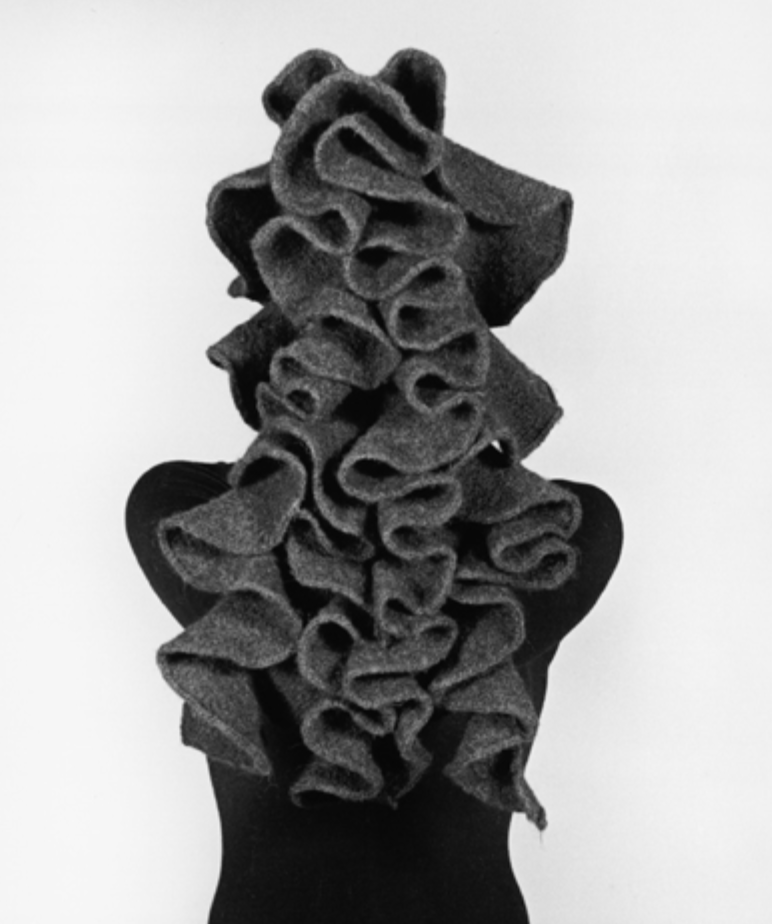
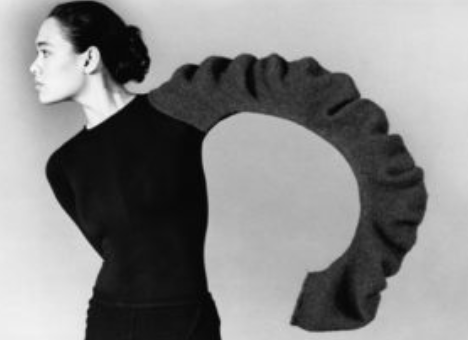
Maria Blaisse
Reading the book The Emergence of Form made me thing about the effect of movement and shape on certain materials. I really like the way Blaisse plays around with different materials.
“For me, form is ‘frozen’ movement; it is completely active.” Maria Blaisse
The first photo on the right is labelled seaweed. Blaisse is continuously inspired by nature in her shapes and I like how she creates these natural looking forms using synthetic material. The second photo shows the bamboo form being used for movement around the human body and using it to mould around. I really like how Blaisse creates new forms with a range of materials and isn't afraid to used both synthetic and natural fibres to create flexible yet frozen forms.



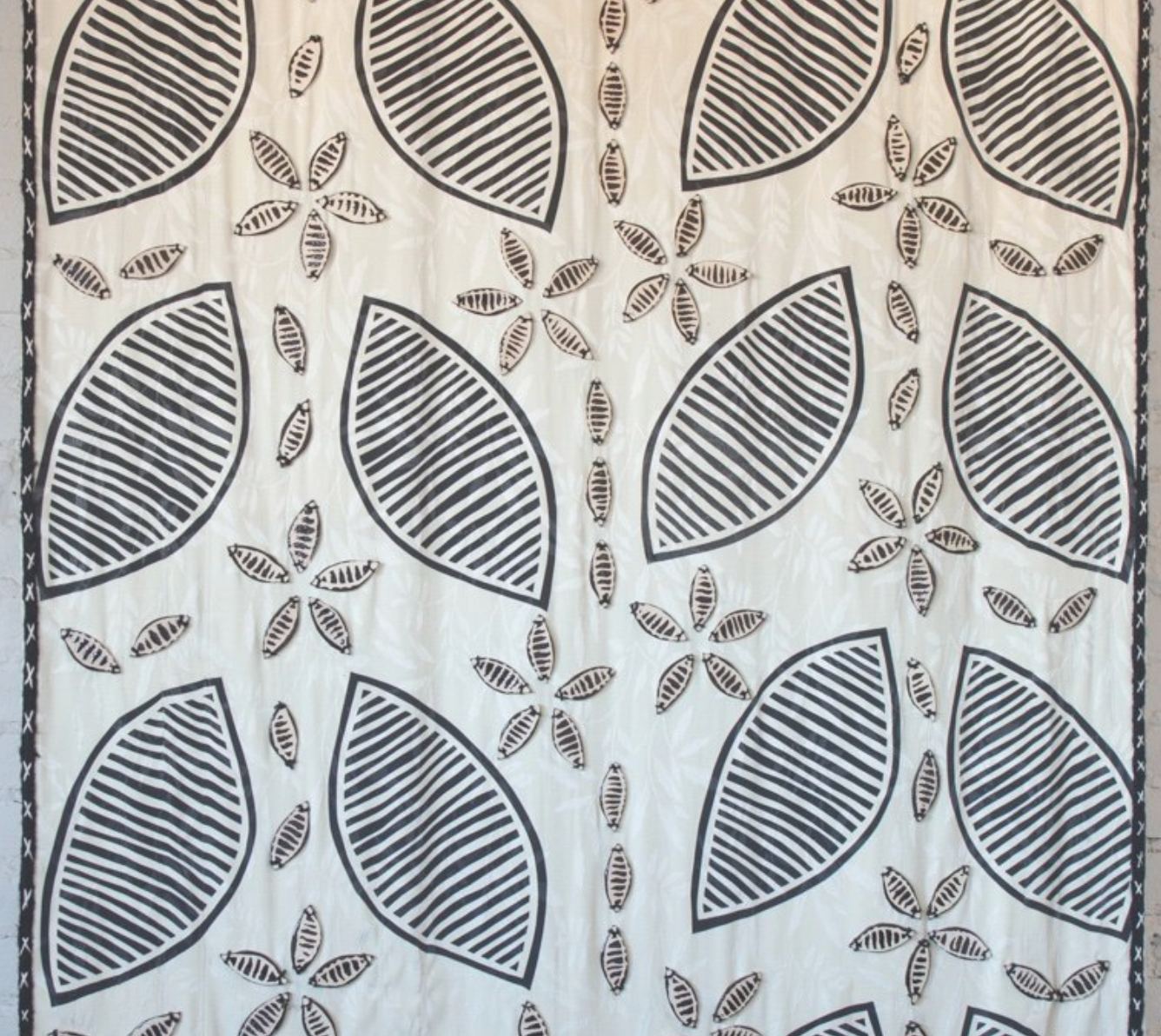
Brigitte Bouquet
I really like how Bouquet has incorporated different materials together to create these fabric tapestries, personally I'm not the biggest fan of the repetition but I do like how the metal comes out of the fabric and makes it more 3D.
Going in to my Level 6 Presentations I was clear that I wanted to explore the knitting in ceramic slip technique. I was interested in the idea of ceramic tiles and the was exploring the connection of the a viewers eyes to the touch of a material. I really liked the idea of connecting my knitted textiles and my cast knitting together as I had research artists that has blended textiles and more solid materials in different ways.
After the feedback given in the Level 6 presentations, I decided to try and see where my knitting mistakes will take me. I knitted three pieces, making notes of time, emotions and how many stitches I felt like strating with. I went with what I felt like knitting in the moment and didn't keep to a specific stitch or shape. I used different weights of yarn and see if I could create different techniques.
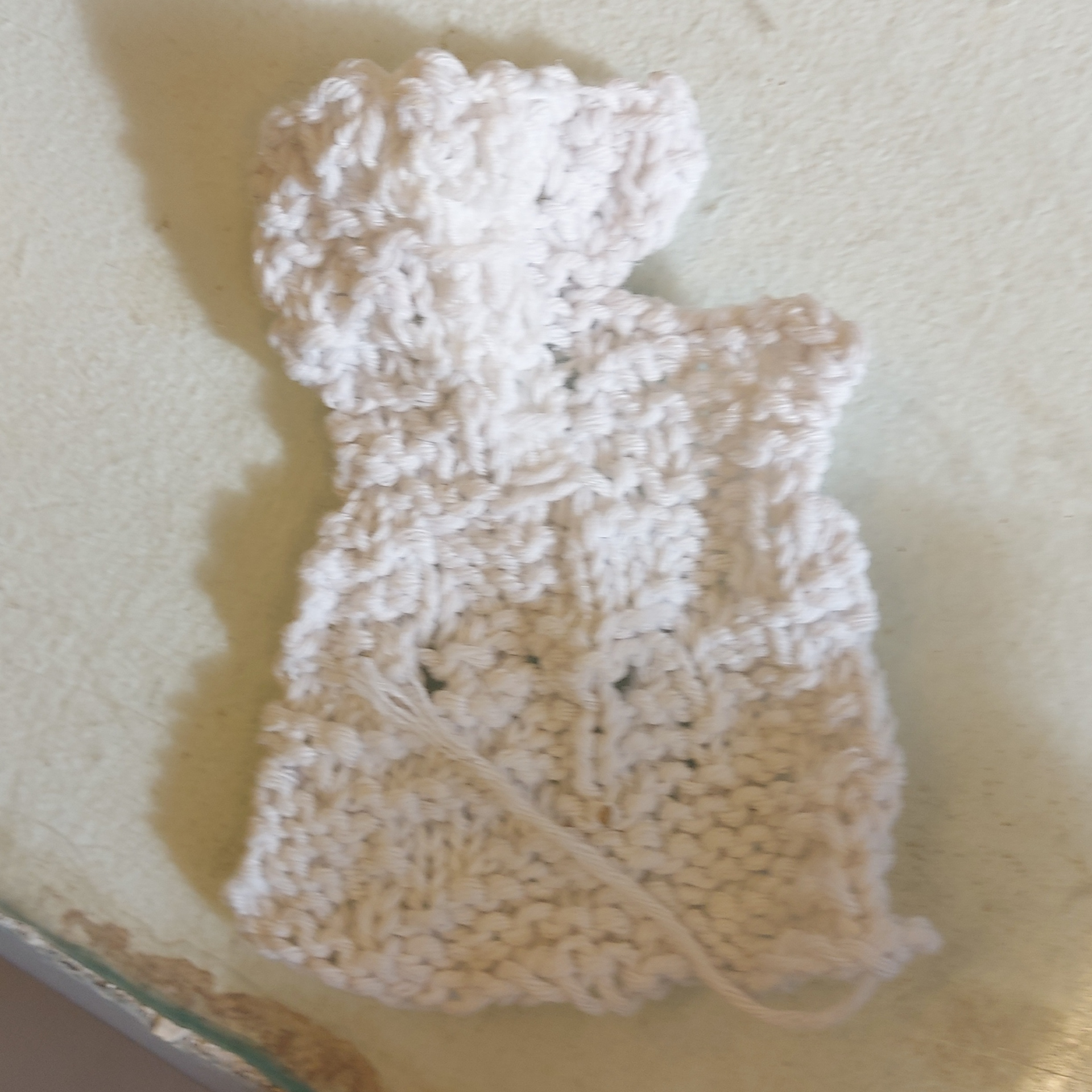
I casted some of the pieces from my experimentation. Some were from the my summer experimentation and others were from the feedback that I received from my presentations. I had not casted in a while so I wanted to cast some different pieces to see how they would turn out. I had to wear a glove to protect a cut I had, however, I think this was good for when I needed to take a photo with a clean hand.
I soaked the knitted cotton in water and wrung it out to make it damp. Then I dipped it in the slip to completely cover the material in the clay. I found that waiting for the majority of the slip to come off can take some time, for a couple of items, I used my hands to wipe the slip off instead of waiting for it to drip off. I would move the clay to try and get the drips of clay off the object as well.
For the drying of the clay I have mainly put it on a flat surface to see how it will turn out. I decided to suspend one piece using the yarn attached to two ends of the knitted piece, although the bottom is touching surface, it will be interesting to see how distorted it might be compared to the rest of the piece.


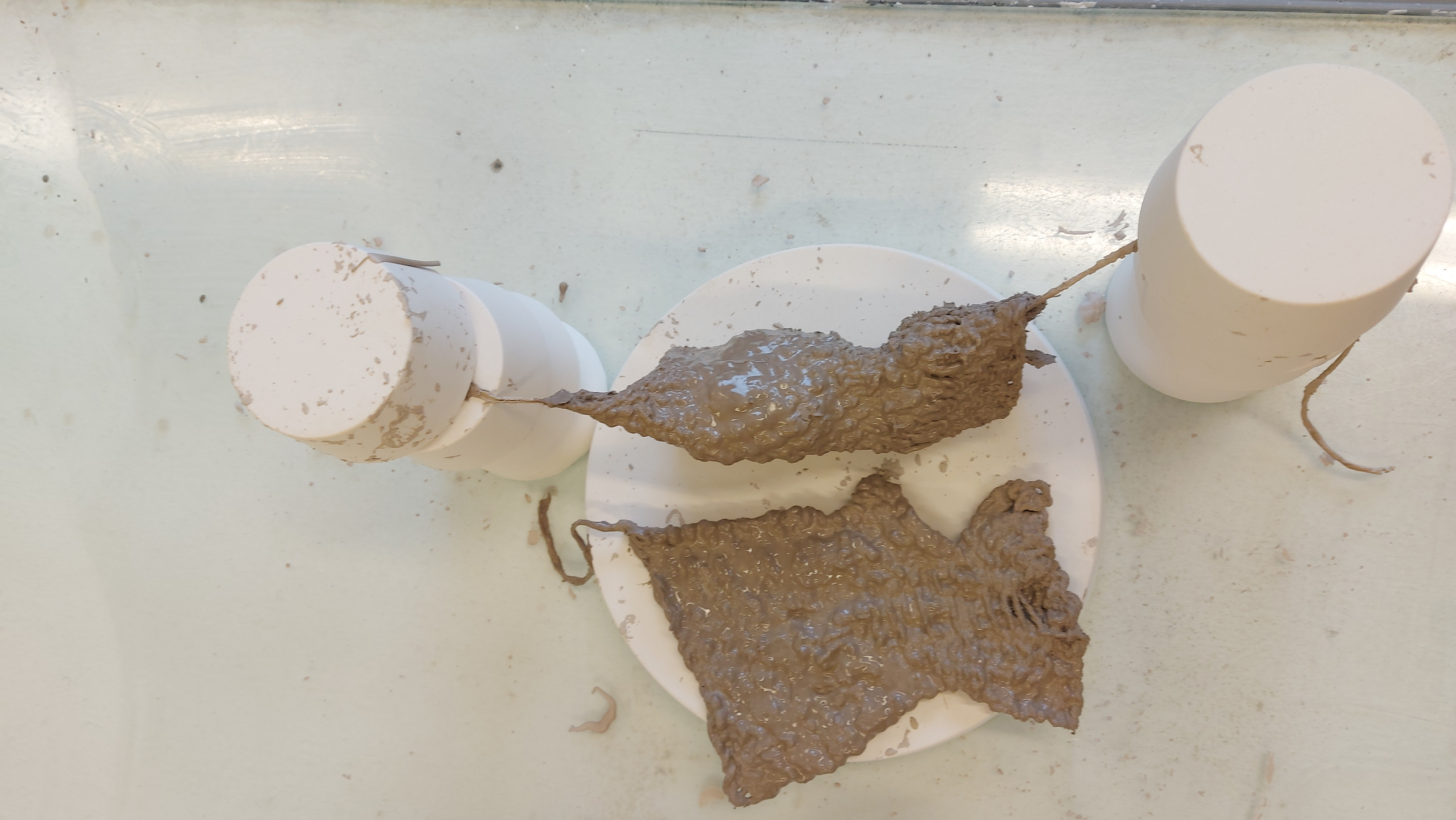

These are the pieces after drying for a day. They are fully dry and some have pooled together. I will see how this works out once fired but I doubt I will get the same effect. The cabled pot-like shape has retained the pattern and texture the most, however, is the slip too thin? I'm not going to know for sure until it comes out of the kiln. I'm not sure when this will happen because the kiln with the extractor fans needed fixing, therefore I will not be able to fire these pieces until this is fixed which should be next week.
I started working on my Instagram reel to show my practice by taking videos of myself knitting. I set myself parameters and changed these slightly for every video I took. My main parameters were:
- Using 4mm circular needles and DK weight yarn
- I knitted in the round
- Doing my work in silence so I could concentrate on my knitting
- Cast on my work and then knitted until the timer got to 30 minutes, then I cast off my work
- Began with 30 stitches on my needles
- Sat at home at my desk and knitted in front of the white background for the video
- I knitted seed stitch (knit one stitch then purl one stitch) repeat, on the next row (purl one then knit one) repeatedly
Instagram reel showing my mistakes in knitting
Using these parameters and changing each one slightly meant that I could explore how each changed parameter affected my work. For example, using bigger needles meant the look of the stitch was changed, however, it also meant that when I accidentally made a hole, it was more noticeable than when I made a hole using smaller needles.
Using seed stitch meant that making mistakes could have a knock on effect on the rest of the piece. I started to see how effective different mistakes were throughout each sample, with slipping stitches being an effective way to knock the seed stitch out of order and disrupting the pattern.
The looks of the finished results were interesting to see as well. The yarn looked bigger with the 8mm needles, I think maybe because the stitches are further apart. Whereas, when using twisted stitches the stitches were even tighter and closer together.
The thinner 4ply yarn I think showed the mistakes more easily as the stitches were further apart due to using needles that were a bit too big for the yarn.
Accidentally rectifying a mistake by rethreading the stitch onto the needle
Trying to go as fast as I could
Accidentally losing a stitch when turning the work on circular needles
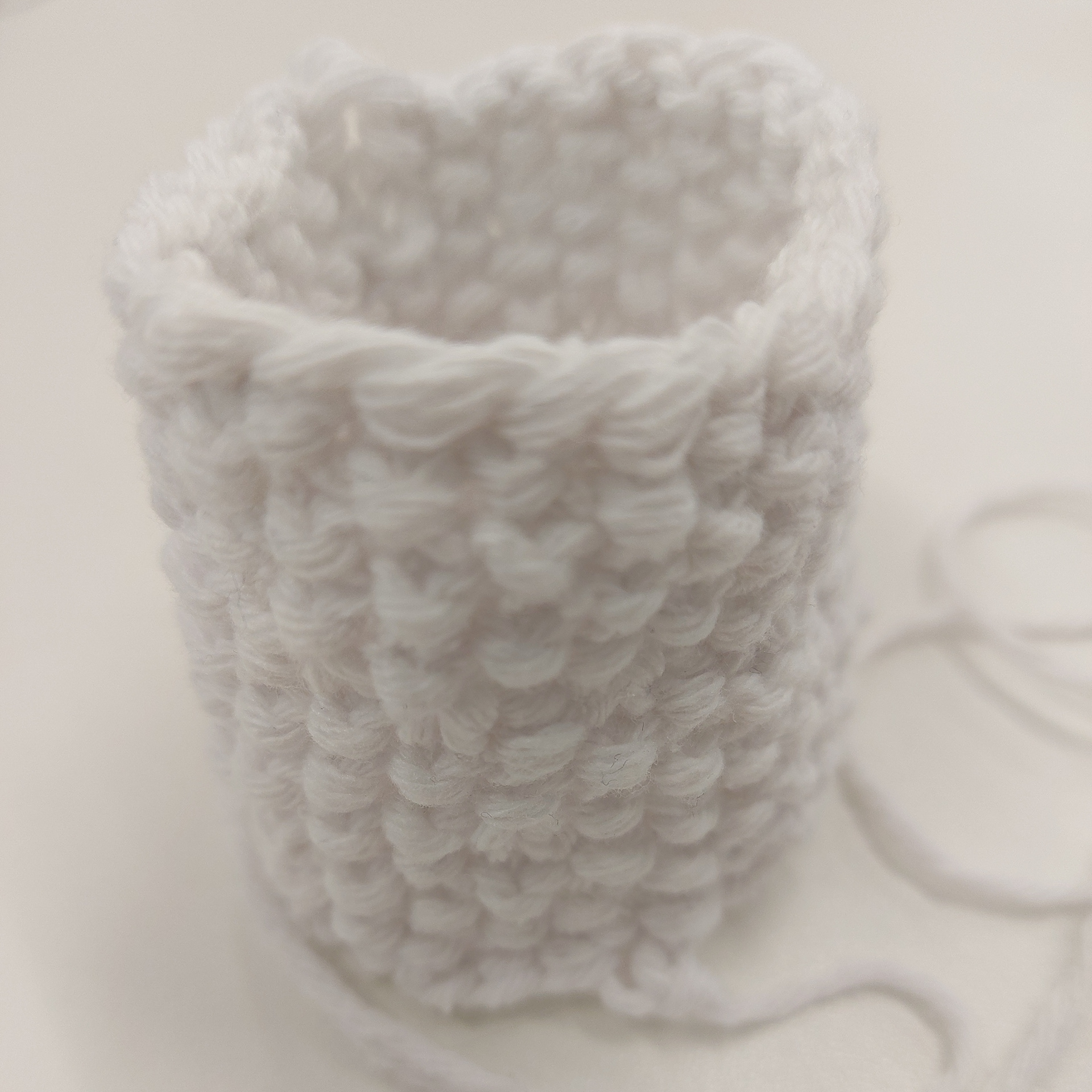
Version 1

Version 1

Version 2
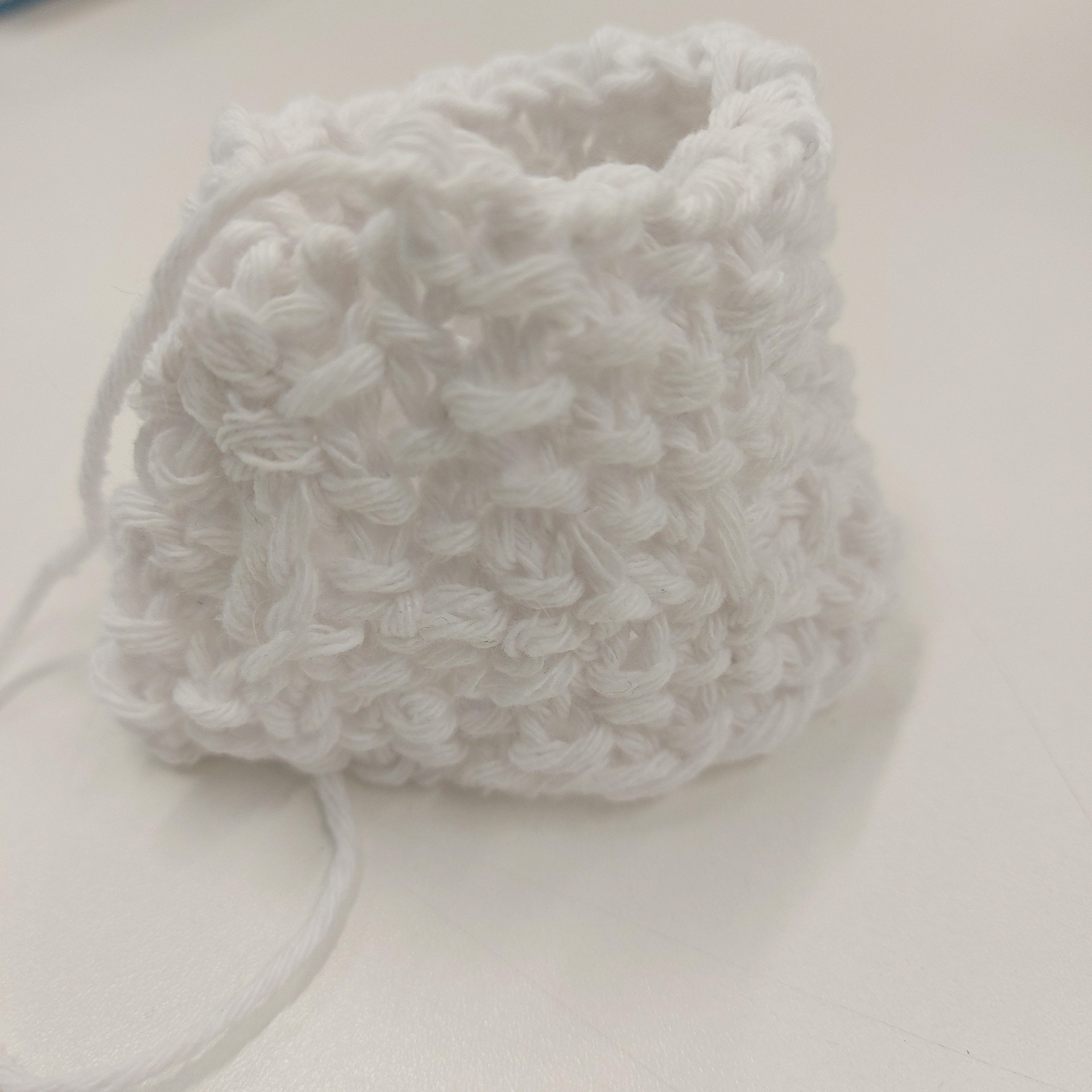
Version 2
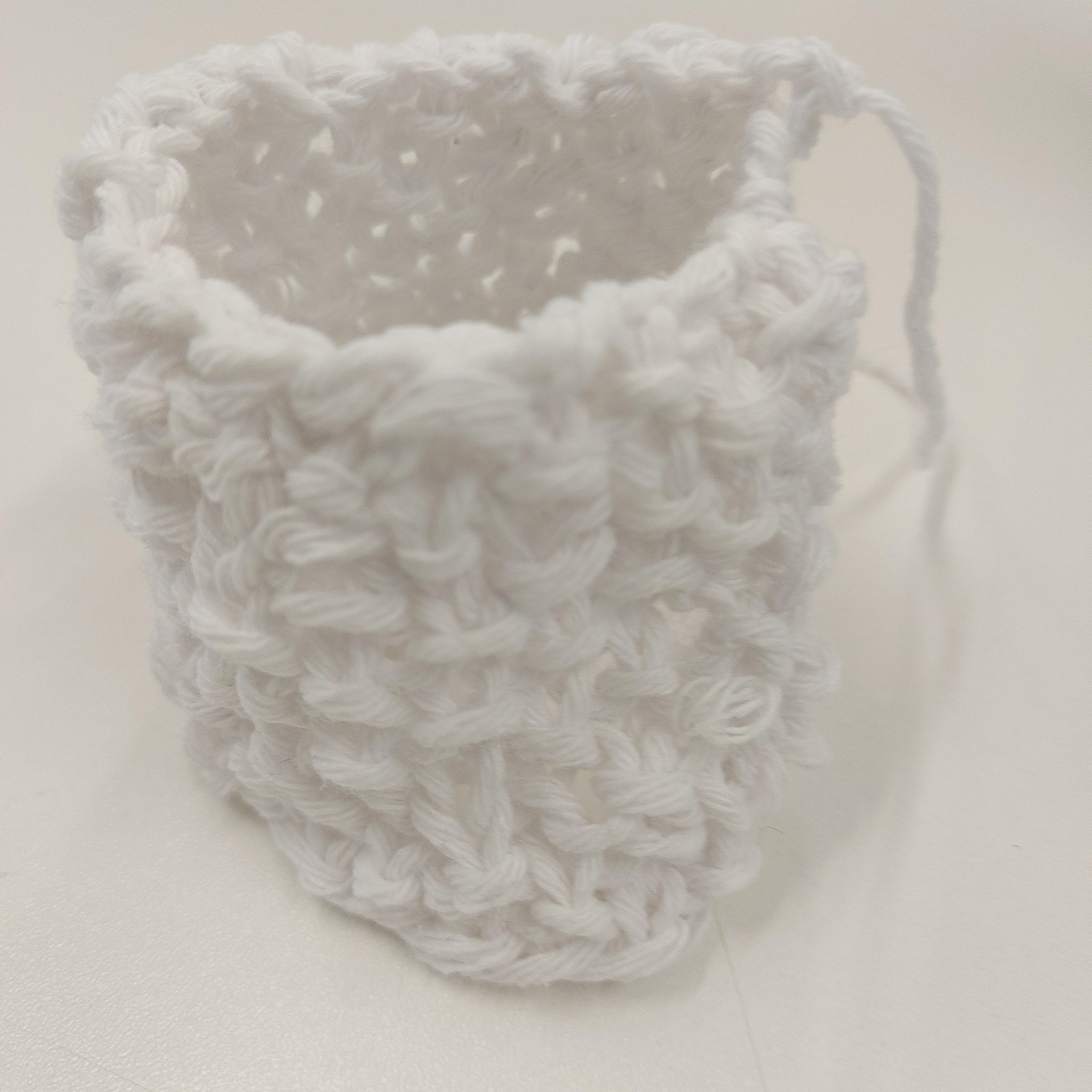
Version 2
Version 1 - kept to all parameters in the above text. I found that so far this is the piece I have made the least mistakes. This could be because I was still unconsciously fixing mistakes and still getting used to leaning into these mistakes.
Version 2 - This was using 8mm needles, double the size of the needles I used for version 1. I found that it could sometimes be difficult to insert the needle into the yarn because it was so small. Normally the most difficult part is the beginning as you need to 'set up' the knitted piece.
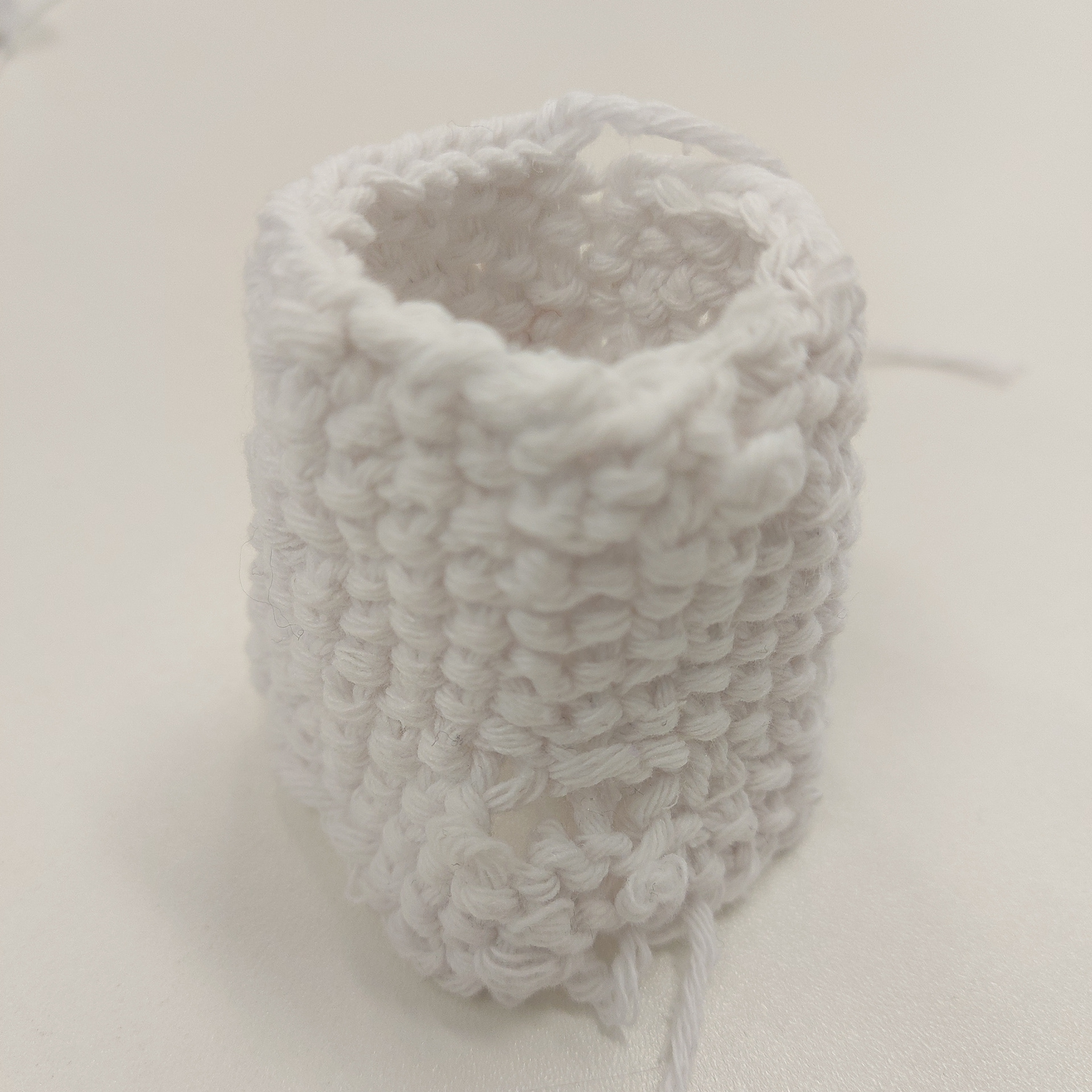
Version 3

Version 3

Version 4
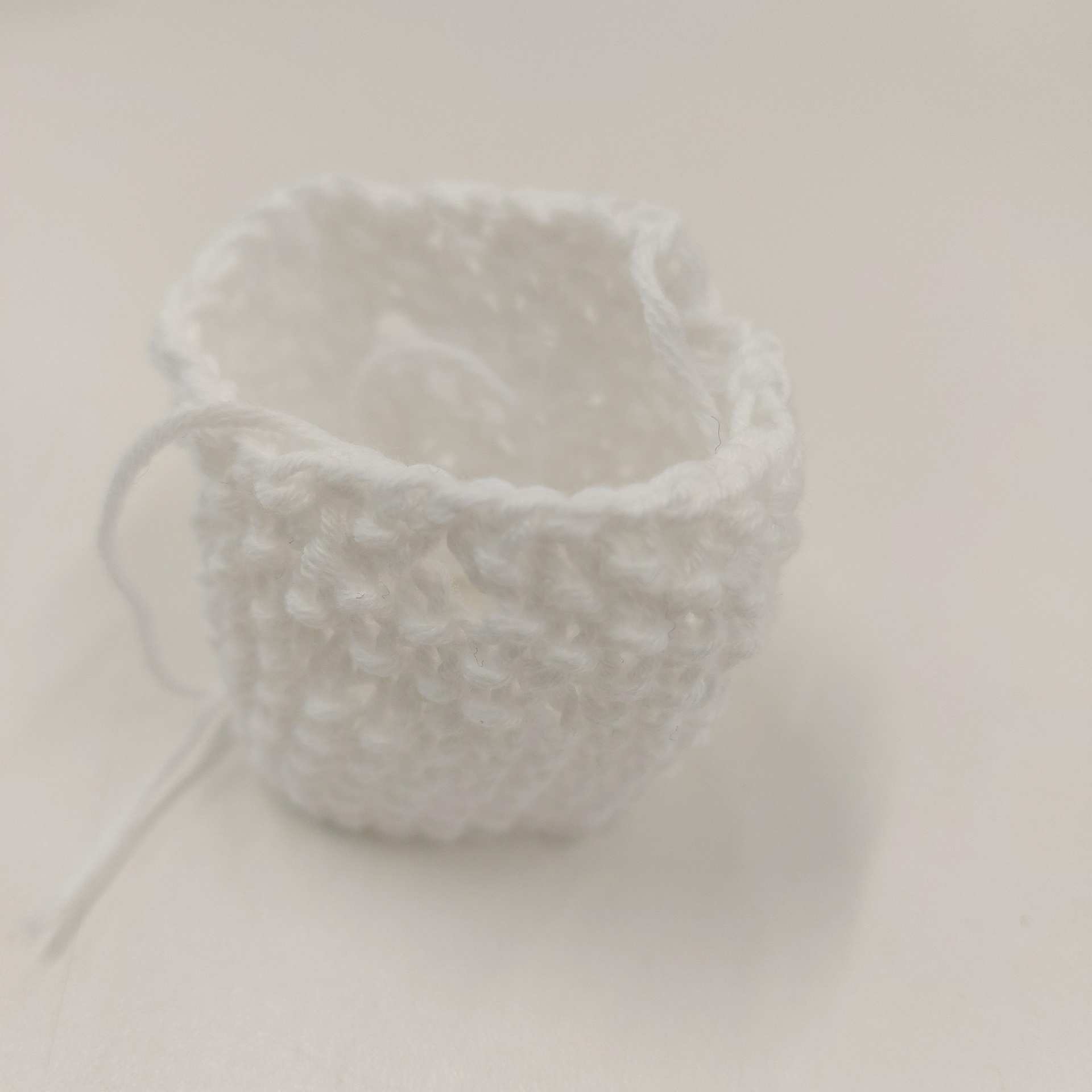
Version 4
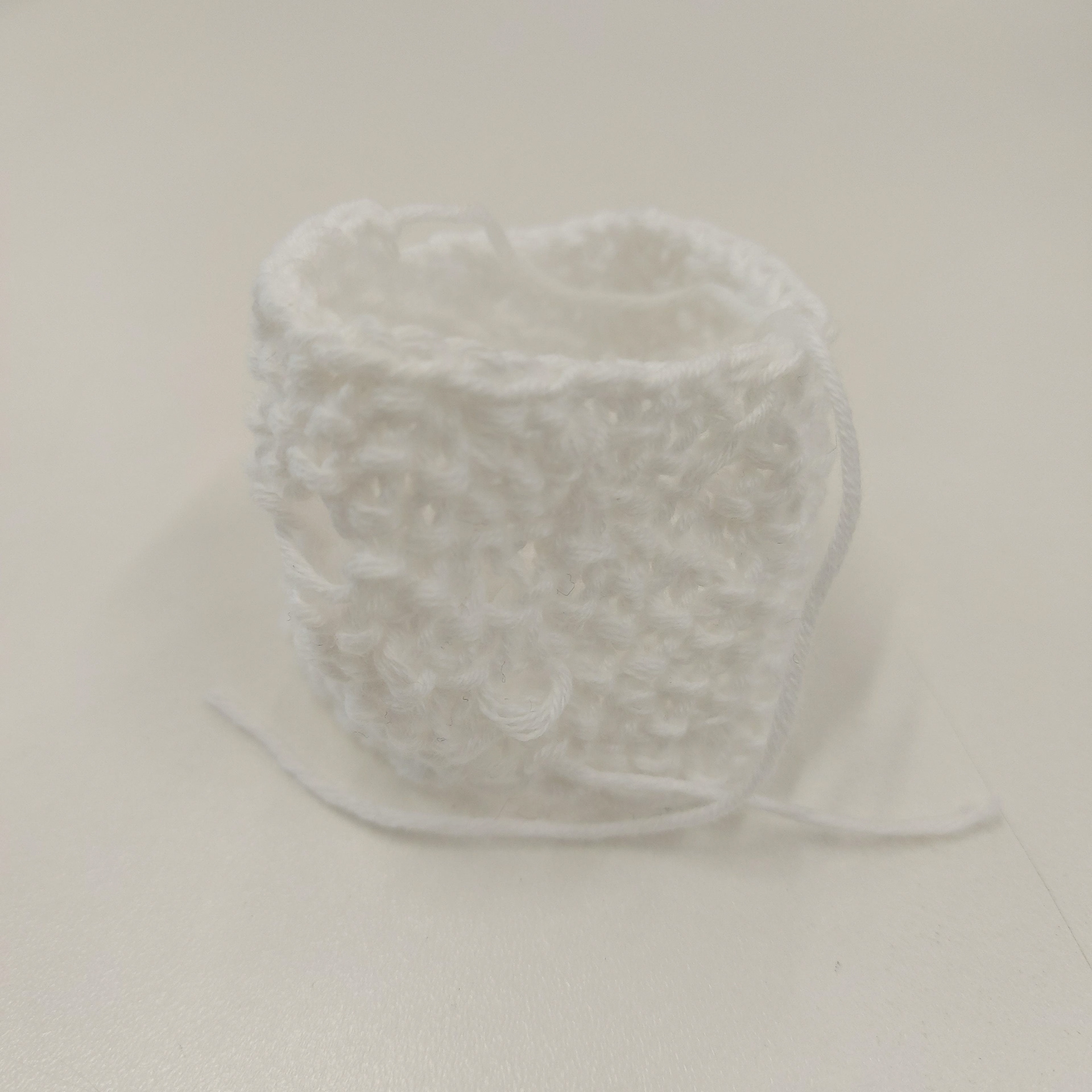
Version 4
Version 3 - these were the mistakes that were made after going as fast as I could for 30 minutes. I found that I slipped so many stitches, which meant that the diameter of the piece became slightly smaller as I went along.
Version 4 - these pieces were knitted using 4ply yarn which is a thinner yarn than DK which is the yarn weight I had been using up until now. This was slightly easier than using the 8mm needles as I am more used to using smaller yarn, however I still made mistakes and slipped stitches.
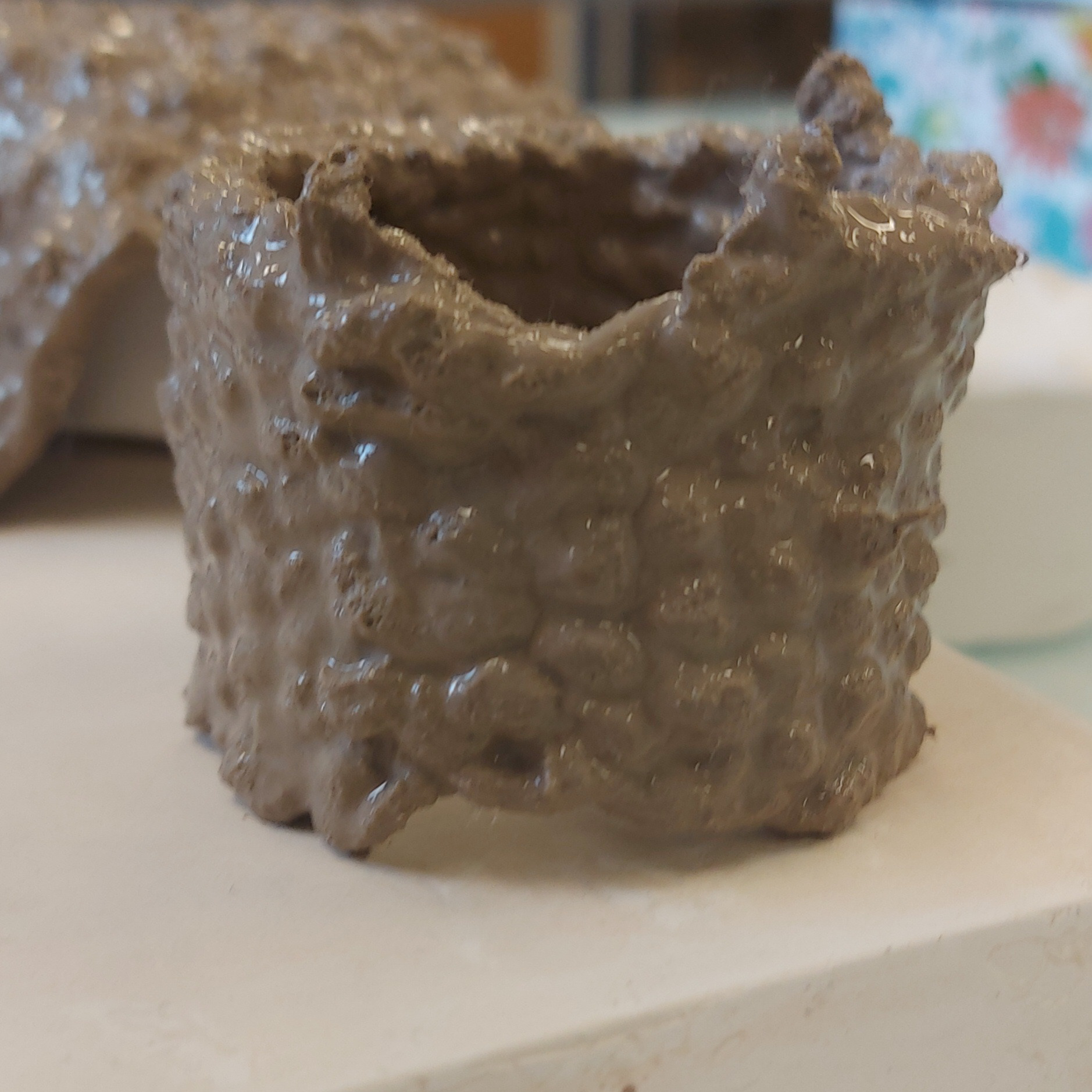
Version 5 (in slip)

Version 6
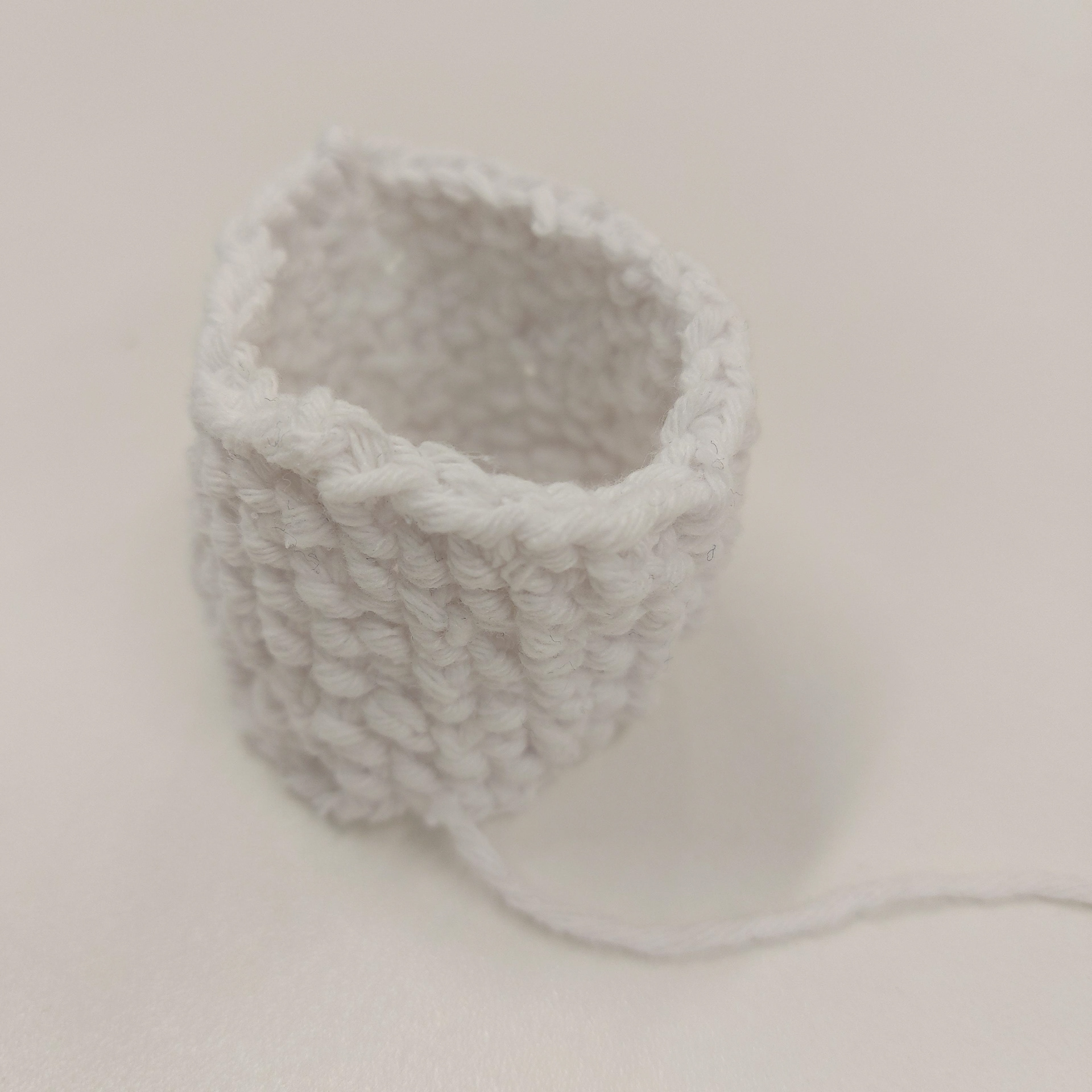
Version 6
Version 5 (in slip) - this knitting was knitted while I looked through the phone screen while it was recording. This particularly challenged me as I had to change my posture completely while having a slight disconnect between my hands and seeing what i knit. I found that I made a lot more mistakes and the was less height to the finished piece as I had to go slower.
Version 6 - this sample was knitted using twisted knit stitches. This meant that I knitted through the back of the stitch instead of the front, this normally makes the stitches tighter and overall gave a different look to the seed stitch. I found that I still made mistakes, but that they're not as noticeable due to the tight nature of the knitting.
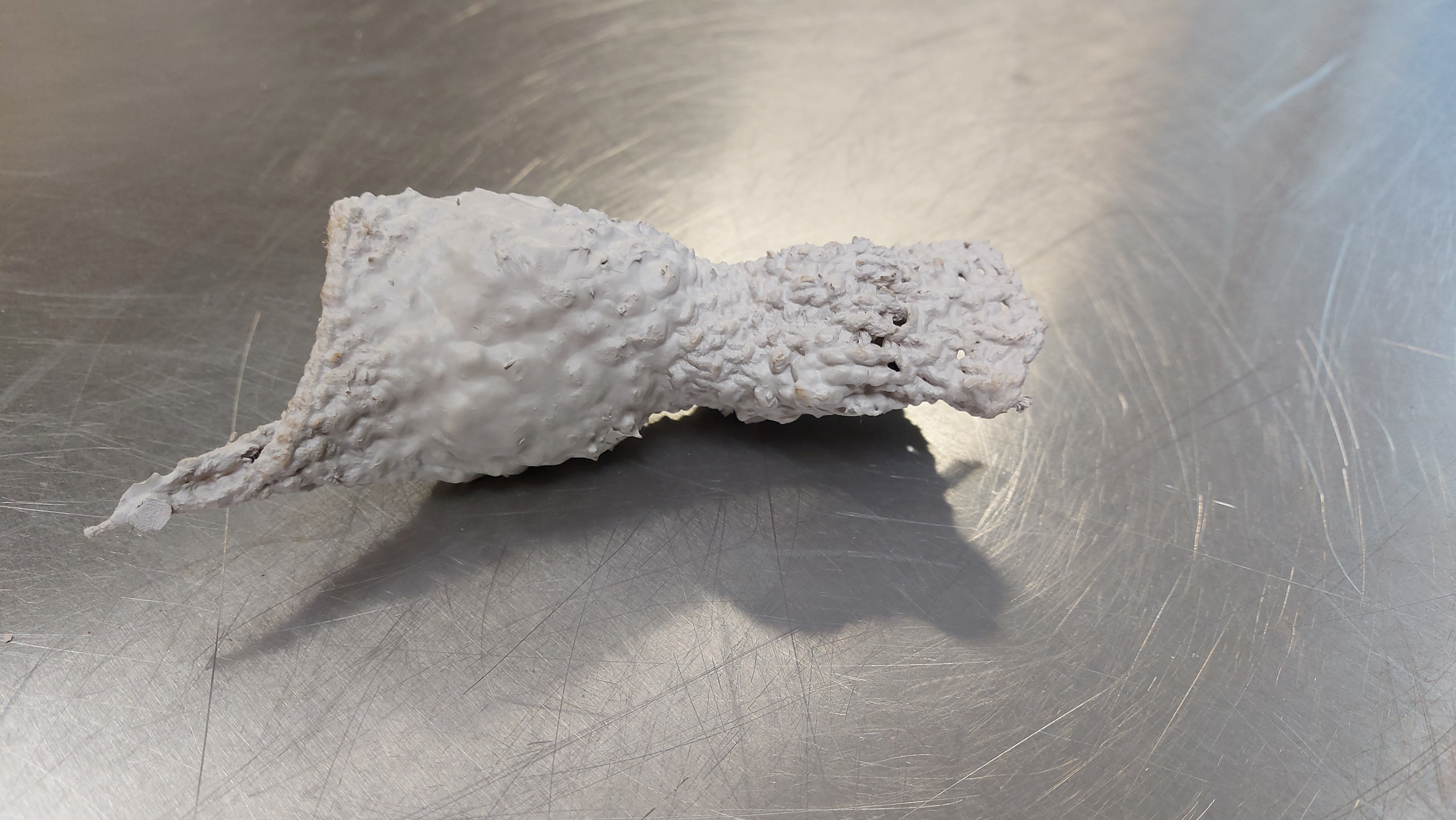
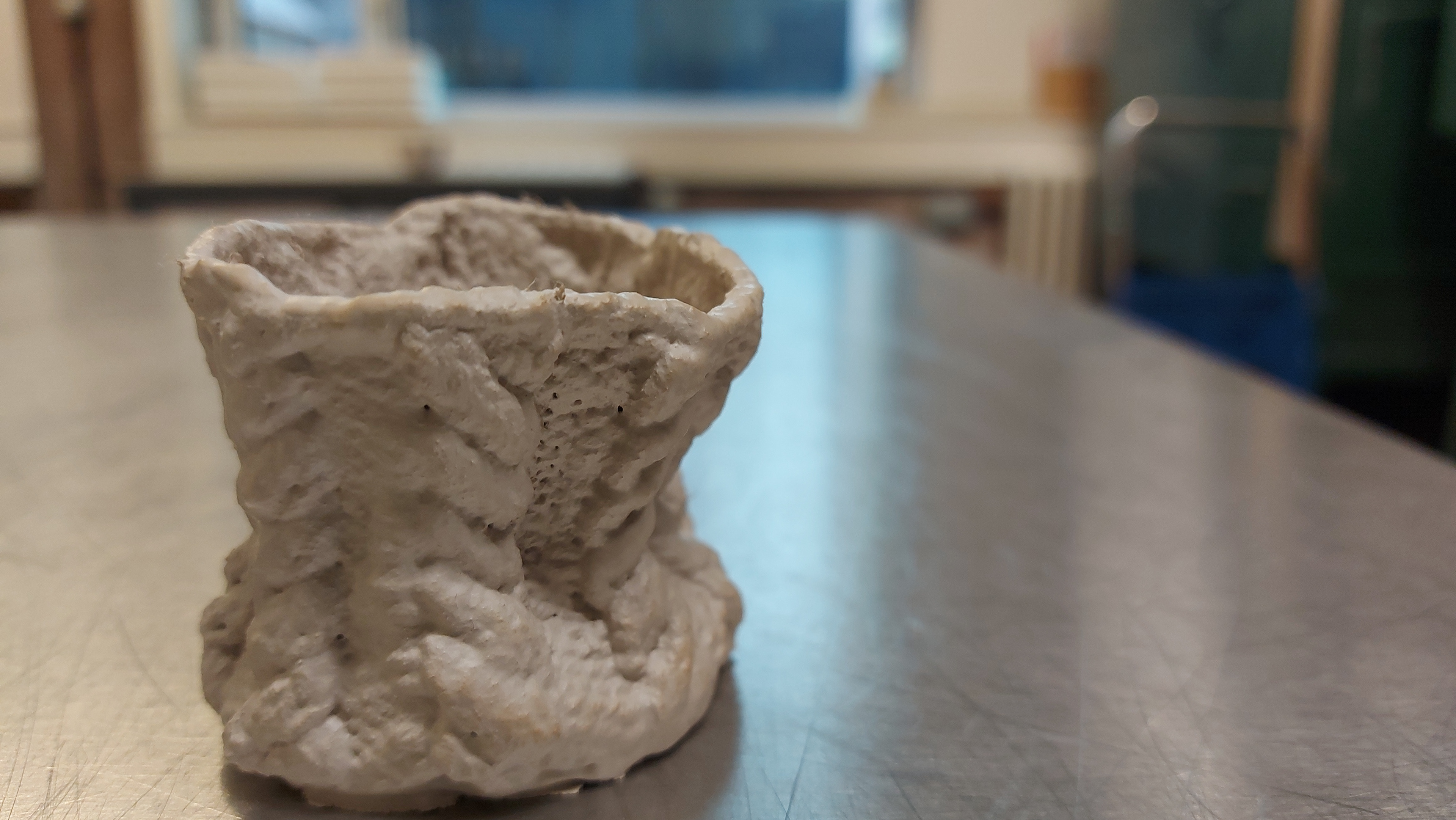
I have continued to cast some knitted pieces, even ones that I had worked on before the start of term. After drying, I wasn't sure about the samples I had cast and saw that a lot of the slip had pooled together which made the stitches less clear, this was not the desired effect I was expecting and I don't expect this to remedied once the work is fired. For now a lot of the samples that I have knitted with the parameters I have kept as soft samples without casting them as I want every single mistake to be visible.
During this round of covering the pieces in slip, I have made as much of a visible imprint as possible with the clay slip. Making sure that the stitches are as visible as possible and not leaving time for the clay to drip off as the slip is so thick.

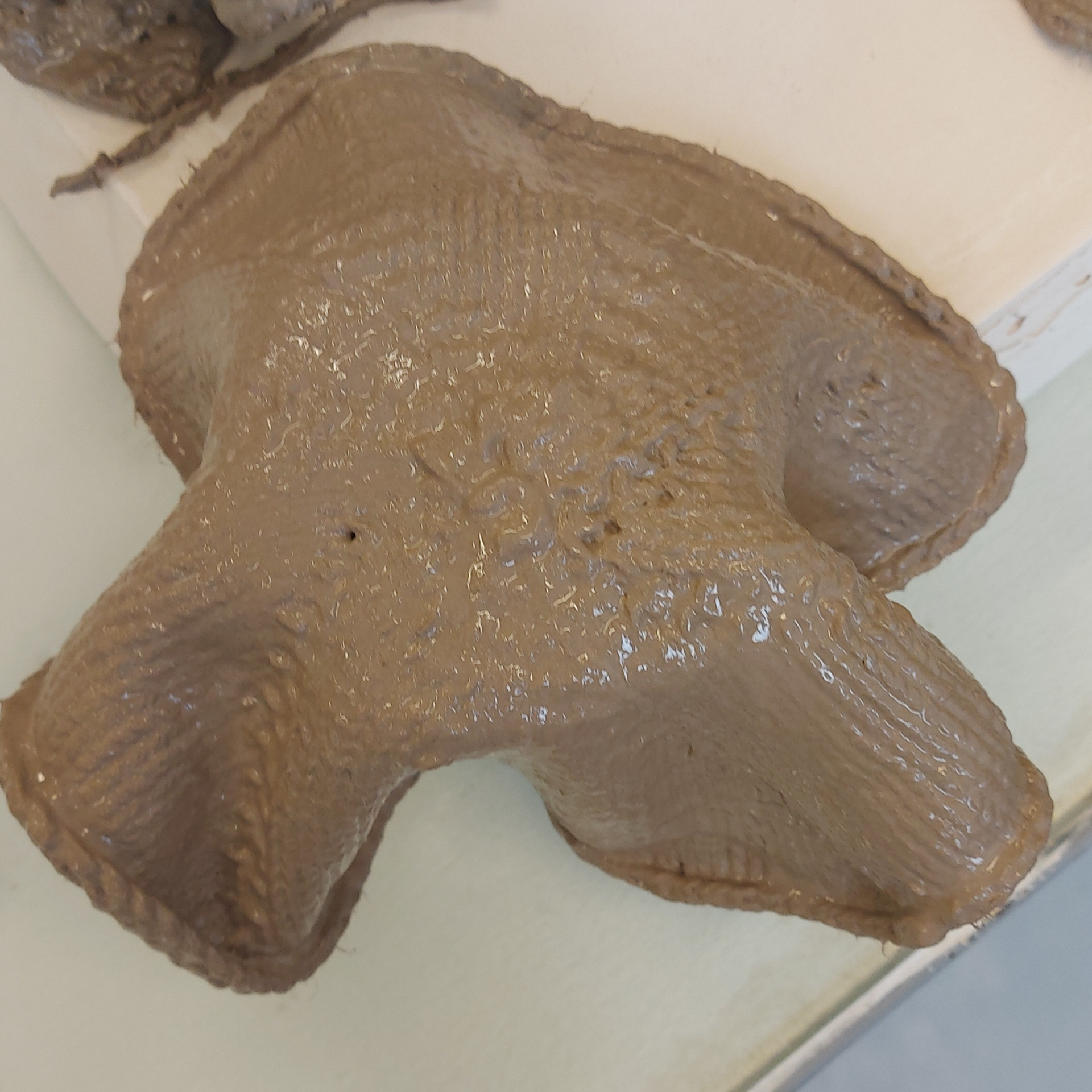

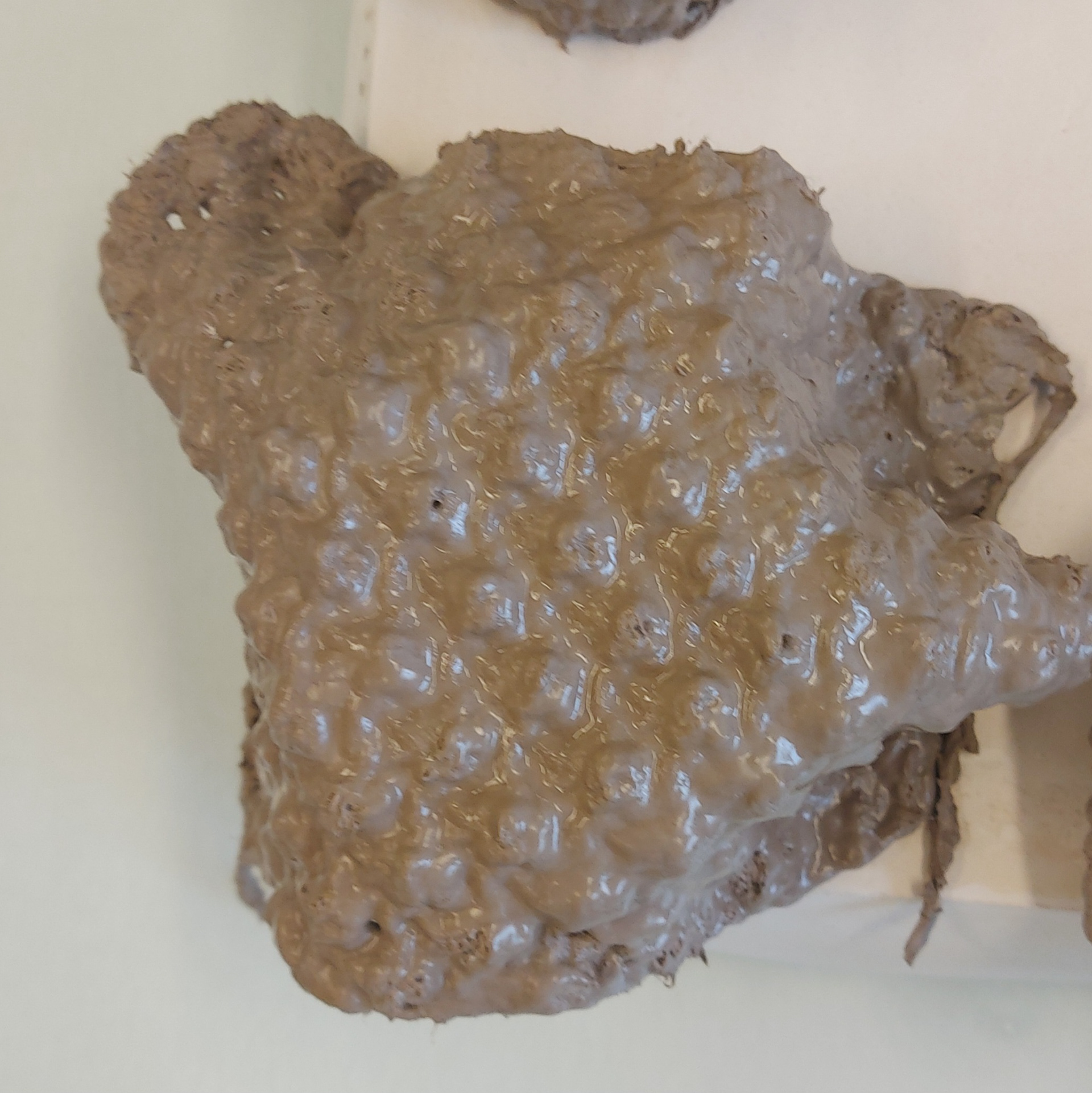
During the videos, I show how I dip the fabric into the slip. The cotton slip has been dampened with water before hand and then dipped inside the slip until it is completely covered, then I spend time getting as much of the clay slip off of the knitted object so that a layer of clay is on the slip, but the stitches are visible underneath.
Knitting and Stitching Show
I visited the Knitting and Stitching Show to get a better understanding of textiles and textile art as a whole. I didn't really know what I was going into but knew textile art was part of the event. Mostly the vendors that were there sold making kits or different tools and materials for makers to buy but overall it was great to see the different textile art. The majority of the work was embroidery but I liked seeing the different influences of the artists and it was inspiring to see how the work was curated. There was art hanging from the ceiling, laid down on the ground and hung up on the wall. The different ways the work was displayed inspired me to think about how my work could be displayed in the future instead of just sat on a table.
Looking at mending and how the delicate nature of clay breaks when not cared for, I broke some of the pieces I had cast. It was a strange experience, breaking something that I had spent time knitting and casting, and it was quite difficult to see it break.
When I examined the broken pieces, the thicker pieces with the breaks have a the texture of the cast fibres inside (see below). Looking into the anatomy was so interesting and I really liked looking at the texture. I was reminded of the sea a lot when examining, the shell like nature of the broken clay, the sea foam/anemone looking features of the inside of the cast.


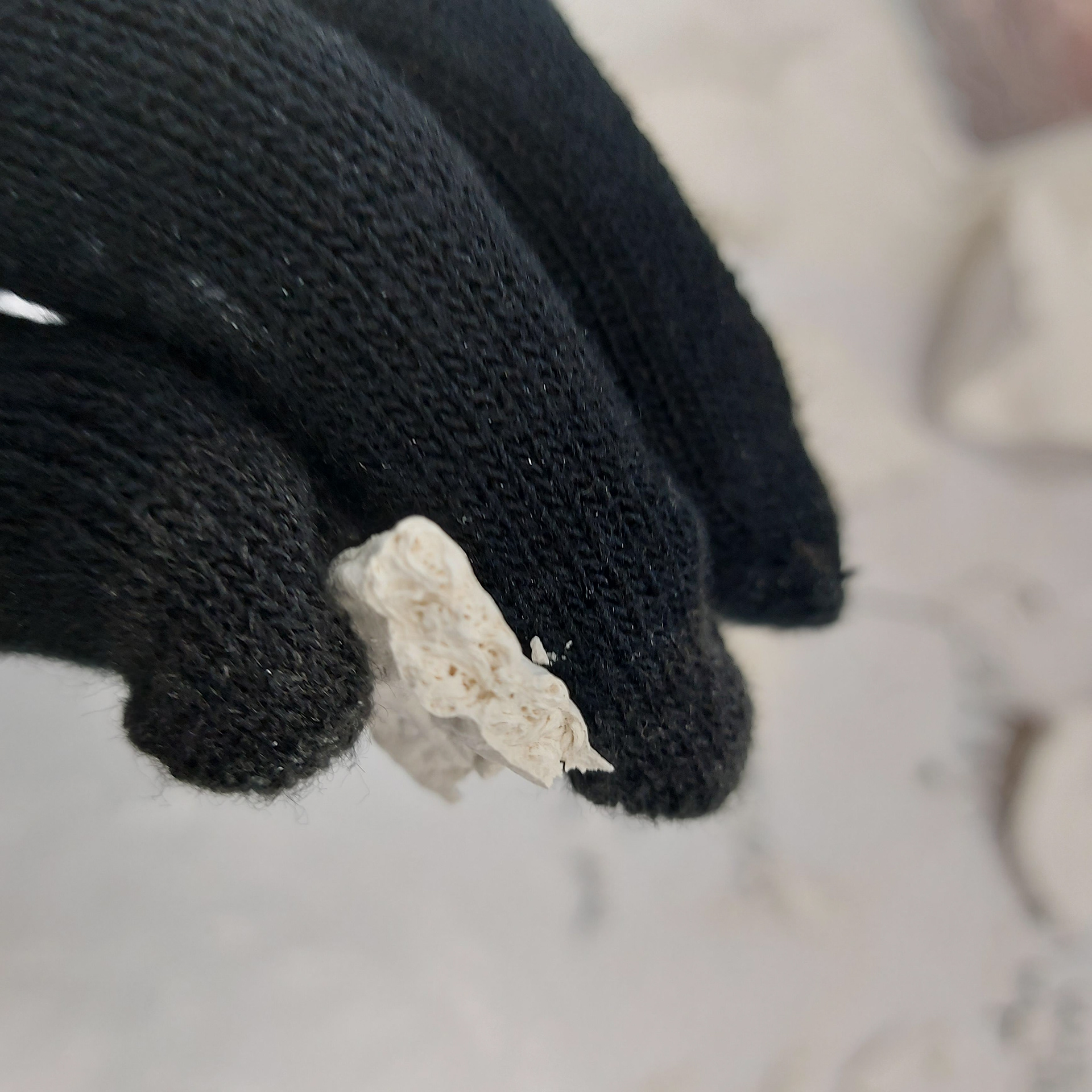
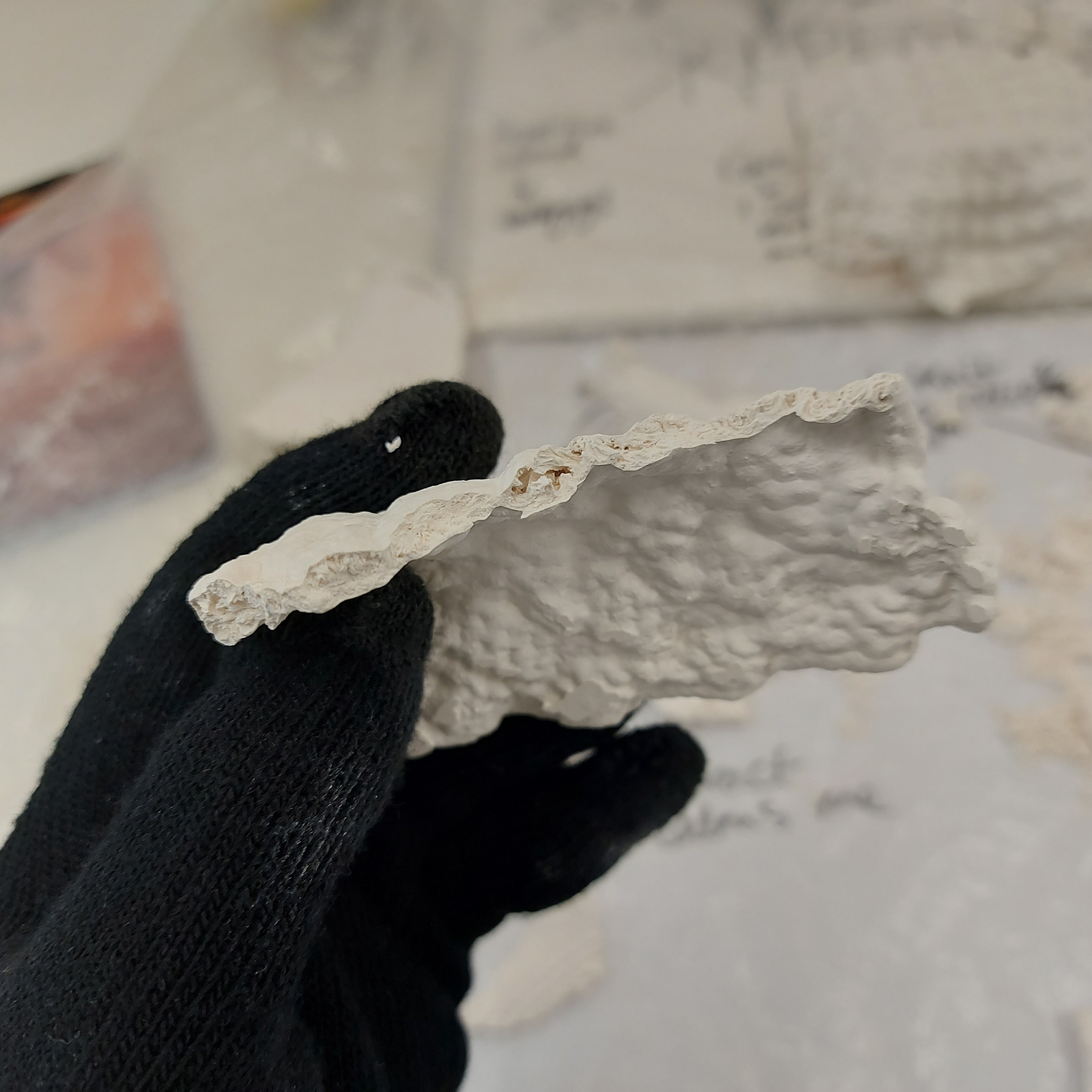
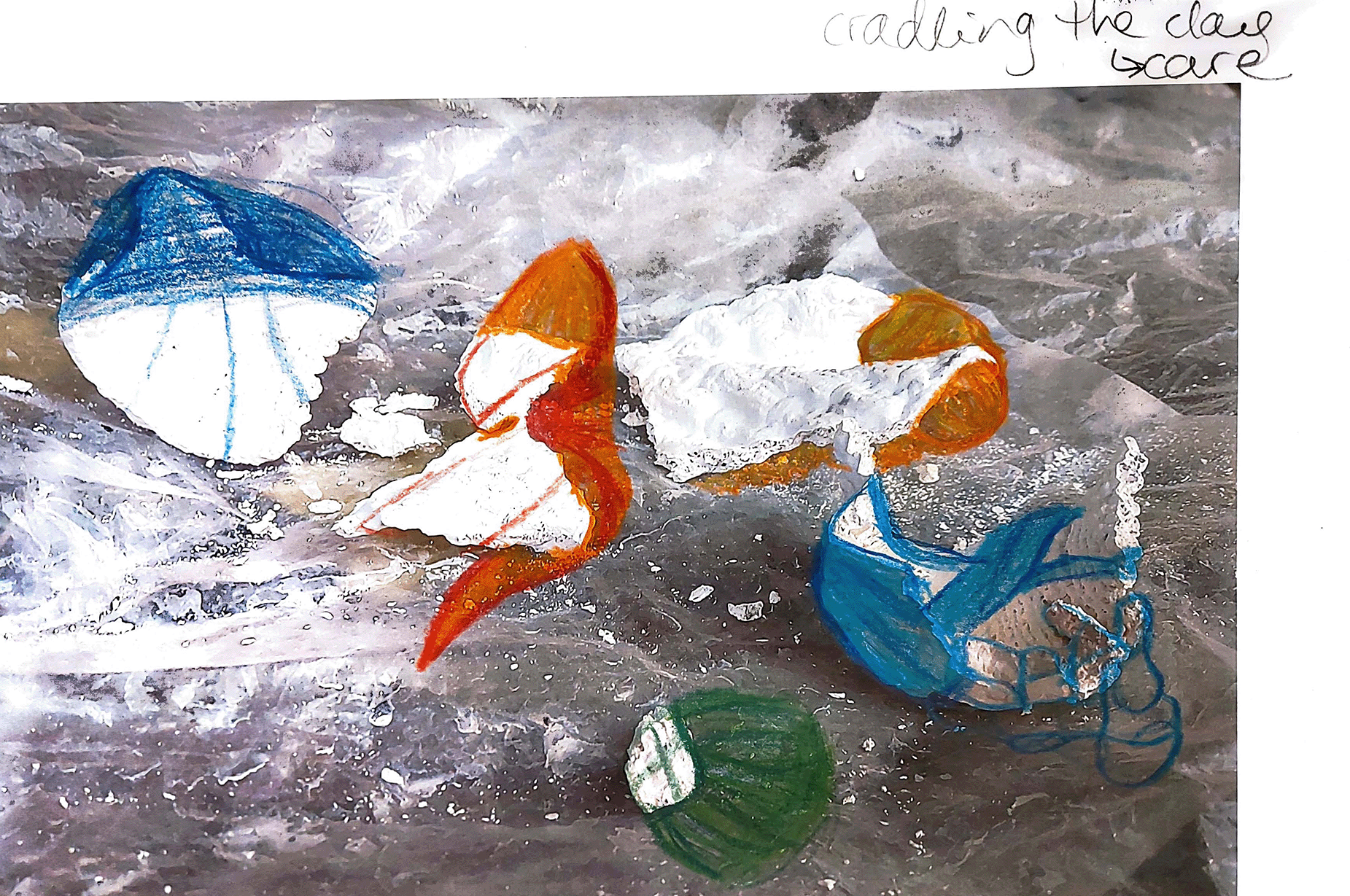

Tutorial 17/10/24
I want to start knitting other pieces to connect the ceramic shards together. These ideas gave me a clear outline for what I needed to do immediately.
I glazed some shards and learnt more about the coloured glazing process. I also contacted the glass technician to see if we could cut some of the shards with the saw that could cut through fired ceramic.
